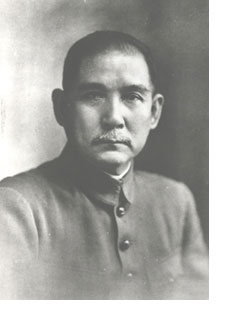首页 > Introduction > Dr. Sun Yat-sen's Biography
Sun Yat-sen's Biography
 Dr. Sun Yat-sen, called Dixiang in his childhood, also known as Wen, Deming and Rixin, and later called Yat-sen, is so named because he used the alias “Zhongshan Qiao” when he stayed in Japan.
Dr. Sun Yat-sen, called Dixiang in his childhood, also known as Wen, Deming and Rixin, and later called Yat-sen, is so named because he used the alias “Zhongshan Qiao” when he stayed in Japan.
On November 12, 1866, Sun Yat-sen was born in an ordinary farmer family in Cuiheng Village. He studied at a private school at 9, studied in Honolulu at 13, and returned home at 17. In 1884, he married Lu Muzhen from the same county. From 1886 to 1892, he studied medicine in Guangzhou and Hong Kong successively. After graduation, he practiced medicine in Macao and Guangzhou, and participated in political activities to save the nation. After his letter to Qing Prime Minister Li Hongzhang was rejected in 1894, he went to Honolulu again, founded the China Revival Society, and raised the proposition of “overturning the Qing government, resuscitating the Chinese nation, and founding a republican government”.
In 1905, he founded the Chinese Revolutionary League in Tokyo, proposed the Three People’s Principles in a systematical way, and made an intensive debate with the royalists. From 1895 to 1911, he planned many armed uprisings against the Qing government, and persevered despite of repeated frustrations. On October 10, 1911, the Wuchang Uprising, namely the famous “1911 Revolution”, received nationwide response, and led to the destruction of the dictatorship of the Qing government.
On New Year’s Day of 1912, Sun Yat-sen served as Provisional President of Republican China in Nanjing, and created the first republican regime in China’s history. He resigned from the office of President, and was devoted to publicity on economic development in April 1912. Yuan Shikai conspired to restore a monarchy after seizing the presidential position, so Sun Yat-sen initiated the Second Revolution against Yuan in 1913. In 1914, he founded the Chinese Revolutionary Party in Japan. In 1915, he married Soong Ching-ling.
In 1917, a congress extraordinary session was held in Guangzhou, in which the military government of Republican China was organized, and he was elected Generalissimo and thereafter initiated the Constitution Protection Movement. In 1919, he reorganized the Chinese Revolutionary Party into the Chinese Nationalist Party, and served as Prime Minister. In 1921, the formal government of Republican China was organized upon the resolution made in a congress extraordinary session in Guangzhou, and Sun Yat-sen served as President and started constitution protection again. In 1923, Sun Yat-sen established a third regime in Guangzhou, founded the Headquarters of the Generalissimo of Army and Navy, and was reinstated as Generalissimo. In the same year, he accepted the advice of Soviet Russia and the Communist Party of China (CPC), and decided to cooperate with the CPC to advance the National Revolution. In January 1924, the first national congress of the Chinese Nationalist Party was held, in which the Chinese Nationalist Party was reorganized and the Three People’s Principles reinterpreted. In the autumn of the same year, Feng Yuxiang initiated Beijing Coup, and Sun Yat-sen was invited to Beijing to discuss state affairs. On March 12, 1925, he died of liver cancer in Beijing.
